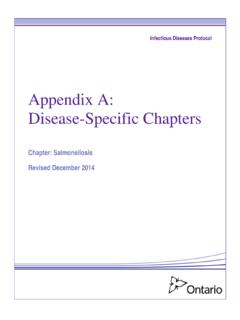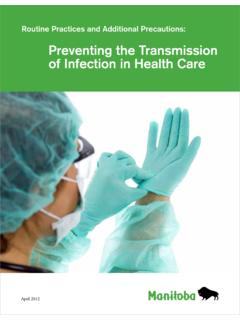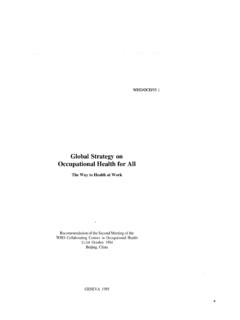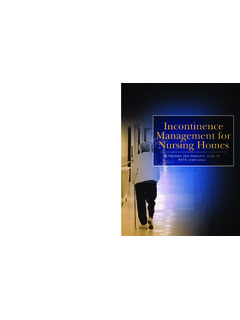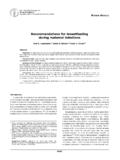Transcription of GUIDELINE FOR PREVENTION OF SURGICAL SITE …
1 Vol. 20 No. 4 INFECTIONCONTROL ANDHOSPITALEPIDEMIOLOGY247 GUIDELINE FORPREVENTION OFSURGICALSITEINFECTION, 1999 Alicia J. Mangram, MD; Teresa C. Horan, MPH, CIC; Michele L. Pearson, MD; Leah Christine Silver, BS; William R. Jar vis, MD; The Hospital Infection Control Practices Advisor y CommitteeHospital infections ProgramNational Center for Infectious DiseasesCenters for Disease Control and PreventionPublic Health Ser viceUS Department of Health and Human Ser vicesHospital Infection Control Practices Advisor y Committee Membership List, Januar y 1999 CHAIRMANE laine L. Larson, RN, PhD, FAAN, CICC olumbia University School of NursingNew York, New YorkEXECUTIVE SECRETARYM ichele L. Pearson, MDCenters for Disease Control and PreventionAtlanta, GeorgiaSURGICAL site INFECTION GUIDELINE SPONSORJ ames T. Lee, MD, PhD, FACSU niversity of MinnesotaMinneapolis, MinnesotaMEMBERSA udrey B.
2 Adams, RN, MPHM ontefiore Medical CenterBronx, New YorkRaymond Y. W. Chinn, MDSharp Memorial HospitalSan Diego, CaliforniaAlfred DeMaria, Jr, MDMassachusetts Department of Public HealthJamaica Plain, MassachusettsJane D. Siegel, MDUniversity of Texas SouthwesternMedical CenterDallas, TexasMarjorie A. Under wood, RN, BSN, CICMt. Diablo Medical CenterConcord, CaliforniaRobert A. Weinstein, MDCook County HospitalChicago, IllinoisSusan W. Forlenza, MDNew York City Health DepartmentNew York, New YorkRamon E. Moncada, MDCoronado Physician s Medical CenterCoronado, CaliforniaWilliam E. Scheckler, MDUniversity of Wisconsin Medical SchoolMadison, Wisconsin248 INFECTIONCONTROL ANDHOSPITALEPIDEMIOLOGYA pril 1999 Table of ContentsEXECUTIVE SUMMARY 250I. SURGICAL site INFECTION (SSI): AN OVERVIEW 251A. Introduction 251B. Key Terms Used in the GUIDELINE 2511. Criteria for defining SSIs 2512.
3 Operating suite 2523. Operating room 2524. SURGICAL personnel 2535. SURGICAL team member 253C. Microbiology 253D. Pathogenesis 253E. Risk and PREVENTION 2541. Patient characteristics 254a. Diabetes 254b. Nicotine use 254c. Steroid use 254d. Malnutrition 255e. Prolonged preoperative hospital stay 256f. Preoperative nares colonization with Staphylococcus aureus256g. Perioperative transfusion 2562. Operative characteristics: Preoperative issues 257a. Preoperative antiseptic showering 257b. Preoperative hair removal 257c. Patient skin preparation in the operating room 257d. Preoperative hand/forearm antisepsis 258e. Management of infected or colonized SURGICAL personnel 258f. Antimicrobial prophylaxis 2583. Operative characteristics: Intraoperative issues 260a. Operating room environment 260b. SURGICAL attire and drapes 261c. Asepsis and SURGICAL technique 2634.
4 Operative characteristics: Postoperative issues 263a. Incision care 263b. Discharge planning 263F. SSI Sur veillance 2631. SSI risk stratification 264a. Concepts 264b. Issues 2642. SSI sur veillance methods 265a. Inpatient SSI sur veillance 265b. Postdischarge SSI sur veillance 265c. Outpatient SSI sur veillance 266G. GUIDELINE Evaluation Process 266 Vol. 20 No. 4 GUIDELINE FORPREVENTION OFSSI249II. RECOMMENDATIONS FOR PREVENTION OF SURGICAL site INFECTION 266A. Rationale 266B. Rankings 266C. Recommendations 2661. Preoperative 266a. Preparation of the patient 266b. Hand/forearm antisepsis for SURGICAL team members 267c. Management of infected or colonized SURGICAL personnel 267d. Antimicrobial prophylaxis 2672. Intraoperative 267a. Ventilation 267b. Cleaning and disinfection of environmental surfaces 267c. Microbiologic sampling 268d. Sterilization of SURGICAL instruments 268e.
5 SURGICAL attire and drapes 268f. Asepsis and SURGICAL technique 2683. Postoperative incision care 2684. Sur veillance 268 References 269 Selected Readings 277 Figure 251 Table 1. Criteria for Defining a SURGICAL site Infection (SSI)252 Table 2. site -Specific Classifications of Organ/Space SURGICAL site Infection253 Table 3. Distribution of Pathogens Isolated From SURGICAL site infections ,National Nosocomial infections Sur veillance System, 1986 to 1996254 Table 4. Operations, Likely SURGICAL site Infection (SSI) Pathogens, and References on Use of Antimicrobial Prophylaxis 255 Table 5. Patient and Operation Characteristics That May Influence the Risk of SURGICAL site Infection Development 256 Table 6. Mechanism and Spectrum of Activity of Antiseptic Agents Commonly Used for Preoperative Skin Preparation and SURGICAL Scrubs 257 Table 7. SURGICAL Wound Classification259 Table 8.
6 Parameters for Operating Room Ventilation, American Institute of Architects, 1996260 Table 9. Parameters for Flash Sterilization Cycles, Association for the Advancement of Medical Instrumentation262 Table 10. Physical Status Classification, American Society of Anesthesiologists264 EXECUTIVE SUMMARYThe GUIDELINE for PREVENTION of SURGICAL SiteInfection, 1999 presents the Centers for Disease Controland PREVENTION (CDC) s recommendations for the preven-tion of SURGICAL site infections (SSIs), formerly called surgi-cal wound infections . This two-part GUIDELINE updates andreplaces previous ,2 Part I, SURGICAL site Infection: An Over view, describes the epidemiology, definitions, microbiology,pathogenesis, and sur veillance of SSIs. Included is adetailed discussion of the pre-, intra-, and postoperativeissues relevant to SSI II, Recommendations for PREVENTION ofSurgical site Infection, represents the consensus of theHospital Infection Control Practices Advisor y Committee(HICPAC) regarding strategies for the PREVENTION of possible, the recommendations in Part II arebased on data from well-designed scientific , there are a limited number of studies that clearlyvalidate risk factors and PREVENTION measures for SSI.
7 Bynecessity, available studies have often been conducted innarrowly defined patient populations or for specific kinds ofoperations, making generalization of their findings to allspecialties and types of operations potentially is especially true regarding the implementation of SSIprevention measures. Finally, some of the infection controlpractices routinely used by SURGICAL teams cannot be rigor-ously studied for ethical or logistical reasons ( , wearingvs not wearing gloves). Thus, some of the recommenda-tions in Part II are based on a strong theoretical rationaleand suggestive evidence in the absence of confirmator y sci-entific has been estimated that approximately 75% of alloperations in the United States will be performed in ambu-lator y, same-day, or outpatient operating rooms by theturn of the centur recommending various SSI preven-tion methods, this document makes no distinction betweensurgical care delivered in such settings and that provided inconventional inpatient operating rooms.
8 This document isprimarily intended for use by surgeons, operating roomnurses, postoperative inpatient and clinic nurses, infectioncontrol professionals, anesthesiologists, healthcare epi-demiologists, and other personnel directly responsible forthe PREVENTION of nosocomial document does not:cSpecifically address issues unique to burns, trau-ma, transplant procedures, or transmission of bloodbornepathogens from healthcare worker to patient, nor does itspecifically address details of SSI PREVENTION in pediatricsurgical practice. It has been recently shown in a multicen-ter study of pediatric SURGICAL patients that characteristicsrelated to the operations are more important than thoserelated to the physiologic status of the gener-al, all SSI PREVENTION measures effective in adult surgicalcare are indicated in pediatric SURGICAL address procedures performed out-side of the operating room ( , endoscopic procedures),nor does it provide guidance for infection PREVENTION forinvasive procedures such as cardiac catheterization orinter ventional radiology.
9 Nonetheless, it is likely that manySSI PREVENTION strategies also could be applied or adaptedto reduce infectious complications associated with recommend SSI PREVENTION methods250 INFECTIONCONTROL ANDHOSPITALEPIDEMIOLOGYA pril 1999 Special ReportGuideline for PREVENTION of SURGICAL site Infection,1999 Alicia J. Mangram, MD; Teresa C. Horan, MPH, CIC; Michele L. Pearson, MD; Leah Christine Silver, BS; William R. Jar vis, MD; The Hospital Infection Control Practices Advisor y CommitteeFrom the Hospital infections Program, National Center for Infectious Diseases, Centers for Disease Control and PREVENTION , Public Health Service,US Department of Health and Human Services, Atlanta, Hospital Infection Control Practices Committee thanks the following subject-matter experts for reviewing a preliminary draft of this GUIDELINE :Carol Applegeet, RN, MSN, CNOR, CNAA, FAAN; Ona Baker, RN, MSHA; Philip Barie, MD, FACS; Arnold Berry, MD; Col.
10 Nancy Bjerke, BSN,MPH, CIC; John Bohnen, MD, FRCSC, FACS; Robert Condon, MS, MD, FACS; E. Patchen Dellinger, MD, FACS; Terrie Lee, RN, MS, MPH, CIC;Judith Mathias, RN; Anne Matlow, MD, MS, FRCPC; C. Glen Mayhall, MD; Rita McCormick, RN, CIC; Ronald Nichols, MD, FACS; Barbara Pankratz,RN; William Rutala, PhD, MPH, CIC; Julie Wagner, RN; Samuel Wilson, MD, FACS. The opinions of all the reviewers might not be reflected in all therecommendations contained in this authors thank Connie Alfred, Estella Cormier, Karen Friend, Charlene Gibson, and Geraldine Jones for providing invaluable Mangram is currently af filiated with the University of Texas Medical Center, Houston, simultaneously in Infection Control and Hospital Epidemiology, the American Journal of Infection Control, and the Journal ofSurgical document is not copyright-protected and may be reprint requests to SSI GUIDELINE , Hospital infections Program, Mailstop E69, Centers for Disease Control and PREVENTION , 1600 CliftonRd, Atlanta, GA GUIDELINE for PREVENTION of SURGICAL site Infection, 1999 is available online at Mangram AJ, Horan TC, Pearson ML, Silver LC, Jarvis WR, the Hospital Infection Control Practices Advisory Committee.










